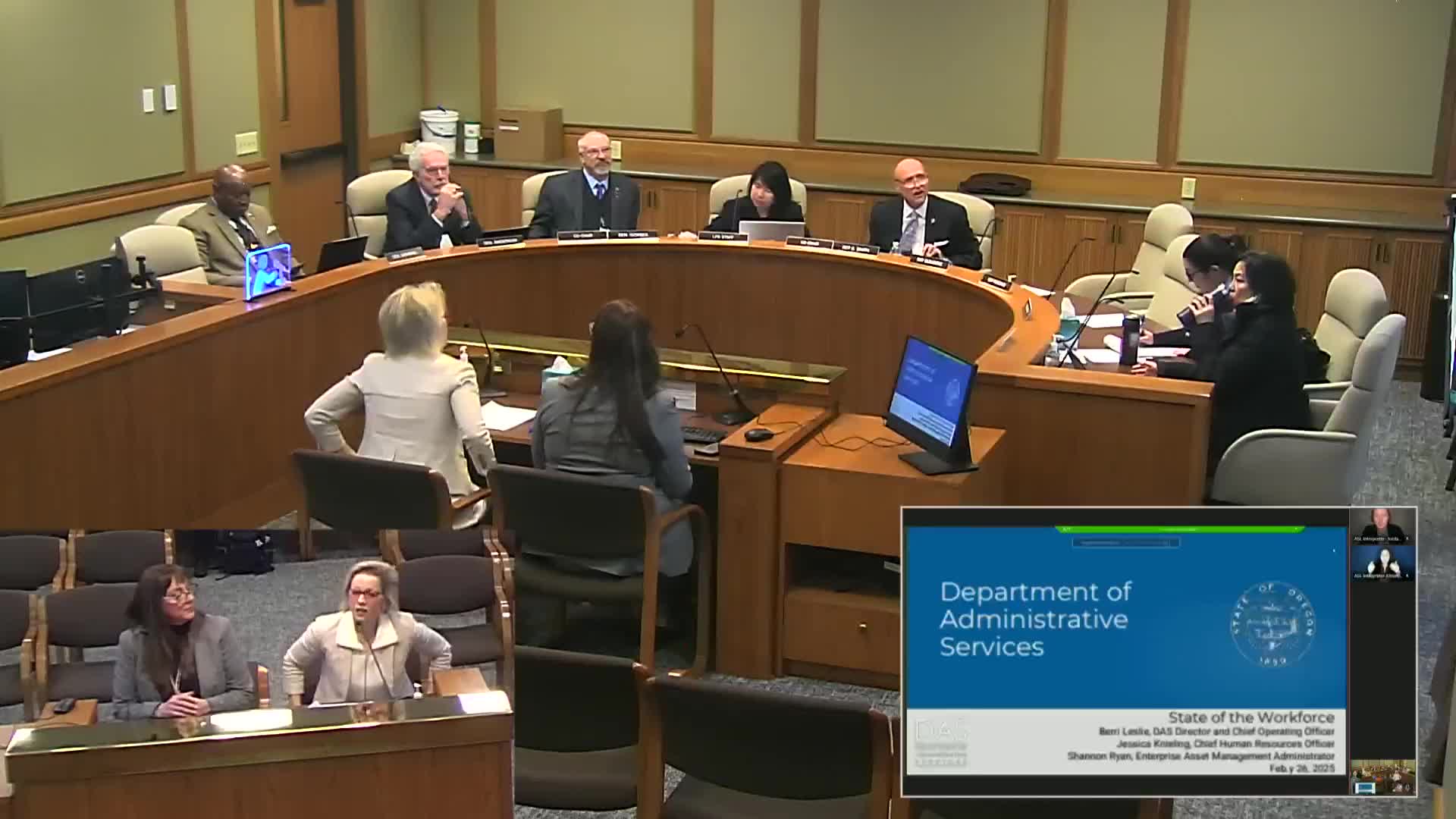DAS outlines four workplace categories; majority of executive-branch employees still report in person
February 26, 2025 | General Government, Ways and Means, Joint, Committees, Legislative, Oregon
This article was created by AI summarizing key points discussed. AI makes mistakes, so for full details and context, please refer to the video of the full meeting. Please report any errors so we can fix them. Report an error »

Barry Leslie, director of the Oregon Department of Administrative Services, and Jessica Neeling, DAS chief human resources officer, told the Joint Committee on Ways and Means Subcommittee on General Government on Feb. 26 that the agency sorts executive-branch work into four categories: full remote, hybrid, in-office and mobile.
Leslie said DAS evaluates work-location decisions using four priorities: customer service, productivity/performance, retention and recruitment, and employee engagement. "More than a year ago, the governor said, I want to know that agencies are operating at a just a threshold of customer service," Leslie said, explaining that DAS asked agencies to adopt a consistent enterprise-wide customer-service baseline.
Neeling presented data pulled from Workday in January showing that just over half of the executive-branch workforce is full-time in person. She said about 15% of the workforce is full-time remote and roughly 2% of employees are located out of state (the agency counts nearby Washington, e.g., Vancouver, as out of state). Neeling cautioned that a substantial portion of in-person staff are in roles that cannot be performed remotely: "about 68% of that 53% ... there's nothing we could do to ever have them be anywhere other than their worksite," she said, citing correctional officers and field staff as examples.
On screening and hiring tools, Neeling said DAS is not currently using artificial intelligence to screen resumes: "we are not using AI in our screening at all," she said, adding the agency is monitoring developments but does not yet have confidence in an appropriate solution.
Committee members asked how productivity is measured for remote or hybrid employees. Neeling said productivity standards and check-ins remain the manager's responsibility and that quarterly check-ins are required but often insufficient: "you still have to have what those standards are for productivity," she said. She added that managers have tools and practices for regular check-ins and outcome measurement.
The committee discussed a recent Enterprise Information Systems (EIS) expectation requiring employees to be in the office one day per week. Neeling reported that EIS gave more than 30 days' notice before implementing the expectation in January, that the agency saw less than 5% of its employees resign or retire after the change, and that EIS experienced an increase in ADA accommodation requests related to the change; some grievances are active from the initial adjustment.
Neeling said collective bargaining agreements contain telework (formerly "telework") language that largely aligns with the state policy and that, in many contracts, agencies must provide roughly 10 days' notice if rescinding a previously allowed remote arrangement.
Ending: DAS staff said they will continue to monitor customer service, productivity, recruitment and engagement data as they adjust workplace policies; the presentations were informational and no committee votes were taken.
Leslie said DAS evaluates work-location decisions using four priorities: customer service, productivity/performance, retention and recruitment, and employee engagement. "More than a year ago, the governor said, I want to know that agencies are operating at a just a threshold of customer service," Leslie said, explaining that DAS asked agencies to adopt a consistent enterprise-wide customer-service baseline.
Neeling presented data pulled from Workday in January showing that just over half of the executive-branch workforce is full-time in person. She said about 15% of the workforce is full-time remote and roughly 2% of employees are located out of state (the agency counts nearby Washington, e.g., Vancouver, as out of state). Neeling cautioned that a substantial portion of in-person staff are in roles that cannot be performed remotely: "about 68% of that 53% ... there's nothing we could do to ever have them be anywhere other than their worksite," she said, citing correctional officers and field staff as examples.
On screening and hiring tools, Neeling said DAS is not currently using artificial intelligence to screen resumes: "we are not using AI in our screening at all," she said, adding the agency is monitoring developments but does not yet have confidence in an appropriate solution.
Committee members asked how productivity is measured for remote or hybrid employees. Neeling said productivity standards and check-ins remain the manager's responsibility and that quarterly check-ins are required but often insufficient: "you still have to have what those standards are for productivity," she said. She added that managers have tools and practices for regular check-ins and outcome measurement.
The committee discussed a recent Enterprise Information Systems (EIS) expectation requiring employees to be in the office one day per week. Neeling reported that EIS gave more than 30 days' notice before implementing the expectation in January, that the agency saw less than 5% of its employees resign or retire after the change, and that EIS experienced an increase in ADA accommodation requests related to the change; some grievances are active from the initial adjustment.
Neeling said collective bargaining agreements contain telework (formerly "telework") language that largely aligns with the state policy and that, in many contracts, agencies must provide roughly 10 days' notice if rescinding a previously allowed remote arrangement.
Ending: DAS staff said they will continue to monitor customer service, productivity, recruitment and engagement data as they adjust workplace policies; the presentations were informational and no committee votes were taken.
View full meeting
This article is based on a recent meeting—watch the full video and explore the complete transcript for deeper insights into the discussion.
View full meeting
